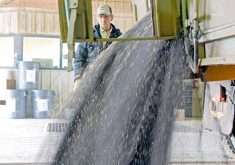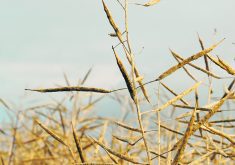With Manitoba farmers starting to bring in their early-maturing soybeans between intermittent rains, they may start to see the toll caused by the dry summer.
Many crop analysts are seeing soybean yields below what farmers have enjoyed for the past couple years, but they stress fields are variable and longer season varieties may give different results once harvest begins on those types.
Cassandra Tkachuk, Manitoba Pulse and Soybean production specialist, said she is seeing smaller seeds and a wide range of yields from 20 to 50 bushels per acre.
Read Also

Farming Smarter receives financial boost from Alberta government for potato research
Farming Smarter near Lethbridge got a boost to its research equipment, thanks to the Alberta government’s increase in funding for research associations.
“So, I think we might end up somewhere in the middle of the road there for average yield, like around 35ish, would be my prediction,” she said.
The average soybean yield for Manitoba is generally considered to be about 35 bu. per acre. Farmers expecting the above-average yields of the past two years might be disappointed.
Bruce Burnett, Glacier FarmMedia’s director of weather and markets information, said soybeans are coming in at lower yields than they have for the past two years but said overall yields might get close to the longer-term average.
“I think the early soybeans might be a bit disappointing in terms of yields, but we’ll have to see what the later soybeans come up with.”
He said the issue most affecting yields was the dry summer, especially in the key filling time in August. He said the number of beans per pod is down and pod size are both concerns.
He said intermittent rains falling in many areas likely won’t be enough to harm plants, unless it drags on and fields become exceptionally wet.
Tkachuk said soybean fields were just starting to mature up when the rains started. Farmers in the Red River Valley have taken off about 40 per cent of their soybeans with farmers in other areas of the province lagging.
“I’m thinking that right around the time that the rain started, quite a few fields were really just maturing up and getting ready to be harvested and then it was just not great timing to finish up,” said Tkachuk.
However, with a few dry days, harvest should be able to progress, she said.
Burnett pointed to decent weather forecasts for the next little while, but he added that it is variable.
He said the southern prairie weather outlook was mostly OK last week but with possible showers for this week, depending on location.
The northern growing areas where cereals and canola were still being harvested, might have a few more problems, he said.
“It’s one of those things where if you’re in the northern growing areas, you’re getting some rains every two or three days.”









!["We're pretty confident there's going to be something in the [federal government's] Fall Economic Statement, but we'll see next week," said Ian Thomson, president of Advanced Biofuels Canada (ABFC). | Getty Images](https://static.producer.com/wp-content/uploads/2023/11/17122957/biofuel-GettyImages-155419399-235x165.jpg)







